Sudipto Mukherjee
Estimation and Prediction of Deterministic Human Intent Signal to augment Haptic Glove aided Control of Robotic Hand
Oct 15, 2021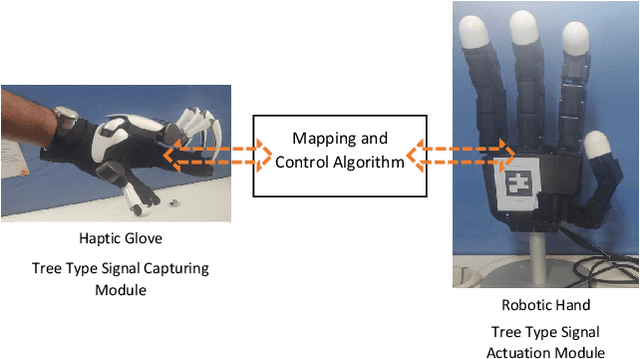
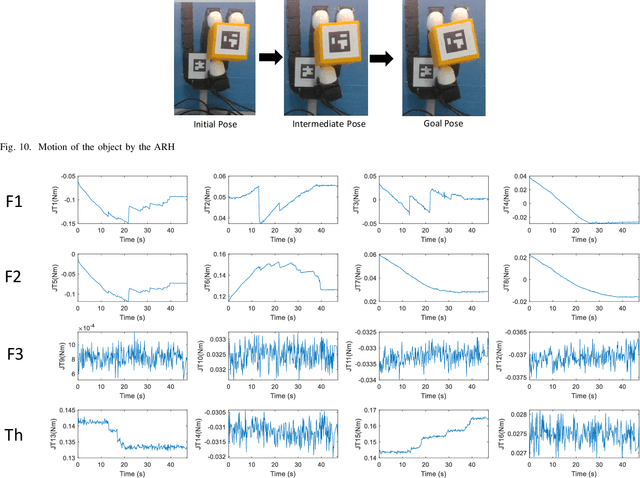
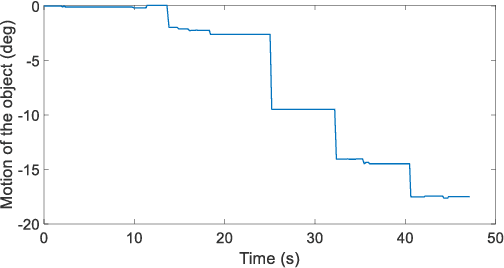
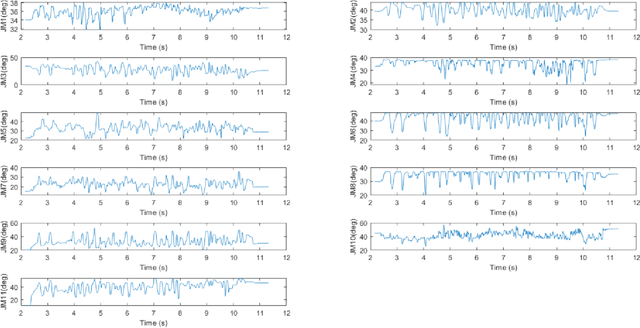
Abstract:The paper focuses on Haptic Glove (HG) based control of a Robotic Hand (RH) executing in-hand manipulation. A control algorithm is presented to allow the RH relocate the object held to a goal pose. The motion signals for both the HG and the RH are high dimensional. The RH kinematics is usually different from the HG kinematics. The variability of kinematics of the two devices, added with the incomplete information about the human hand kinematics result in difficulty in direct mapping of the high dimensional motion signal of the HG to the RH. Hence, a method is proposed to estimate the human intent from the high dimensional HG motion signal and reconstruct the signal at the RH to ensure object relocation. It is also shown that the lag in synthesis of the motion signal of the human hand added with the control latency of the RH leads to a requirement of the prediction of the human intent signal. Then, a recurrent neural network (RNN) is proposed to predict the human intent signal ahead of time.
A note on synthesizing geodesic based contact curves
Feb 21, 2021



Abstract:The paper focuses on synthesizing optimal contact curves that can be used to ensure a rolling constraint between two bodies in relative motion. We show that geodesic based contact curves generated on both the contacting surfaces are sufficient conditions to ensure rolling. The differential geodesic equations, when modified, can ensure proper disturbance rejection in case the system of interacting bodies is perturbed from the desired curve. A corollary states that geodesic curves are generated on the surface if rolling constraints are satisfied. Simulations in the context of in-hand manipulations of the objects are used as examples.
C-MI-GAN : Estimation of Conditional Mutual Information using MinMax formulation
May 17, 2020



Abstract:Estimation of information theoretic quantities such as mutual information and its conditional variant has drawn interest in recent times owing to their multifaceted applications. Newly proposed neural estimators for these quantities have overcome severe drawbacks of classical $k$NN-based estimators in high dimensions. In this work, we focus on conditional mutual information (CMI) estimation by utilizing its formulation as a minmax optimization problem. Such a formulation leads to a joint training procedure similar to that of generative adversarial networks. We find that our proposed estimator provides better estimates than the existing approaches on a variety of simulated data sets comprising linear and non-linear relations between variables. As an application of CMI estimation, we deploy our estimator for conditional independence (CI) testing on real data and obtain better results than state-of-the-art CI testers.
Smart To-Do : Automatic Generation of To-Do Items from Emails
May 05, 2020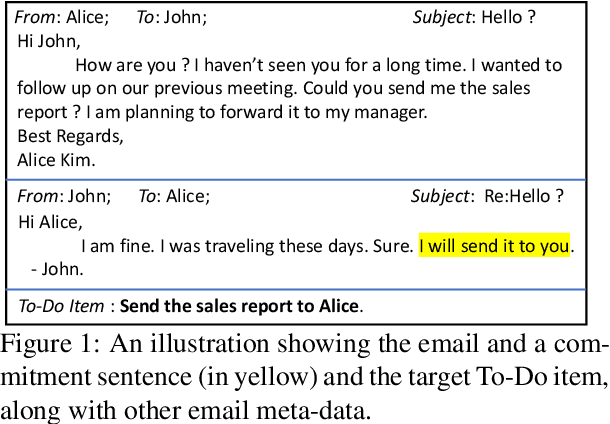

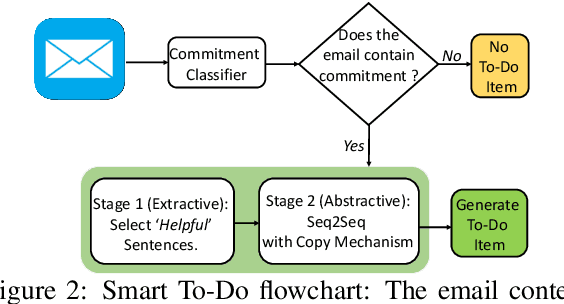
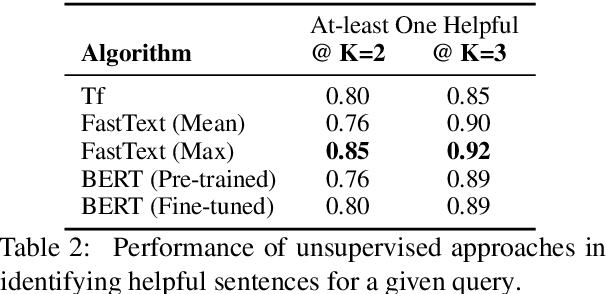
Abstract:Intelligent features in email service applications aim to increase productivity by helping people organize their folders, compose their emails and respond to pending tasks. In this work, we explore a new application, Smart-To-Do, that helps users with task management over emails. We introduce a new task and dataset for automatically generating To-Do items from emails where the sender has promised to perform an action. We design a two-stage process leveraging recent advances in neural text generation and sequence-to-sequence learning, obtaining BLEU and ROUGE scores of 0:23 and 0:63 for this task. To the best of our knowledge, this is the first work to address the problem of composing To-Do items from emails.
CCMI : Classifier based Conditional Mutual Information Estimation
Jun 05, 2019



Abstract:Conditional Mutual Information (CMI) is a measure of conditional dependence between random variables X and Y, given another random variable Z. It can be used to quantify conditional dependence among variables in many data-driven inference problems such as graphical models, causal learning, feature selection and time-series analysis. While k-nearest neighbor (kNN) based estimators as well as kernel-based methods have been widely used for CMI estimation, they suffer severely from the curse of dimensionality. In this paper, we leverage advances in classifiers and generative models to design methods for CMI estimation. Specifically, we introduce an estimator for KL-Divergence based on the likelihood ratio by training a classifier to distinguish the observed joint distribution from the product distribution. We then show how to construct several CMI estimators using this basic divergence estimator by drawing ideas from conditional generative models. We demonstrate that the estimates from our proposed approaches do not degrade in performance with increasing dimension and obtain significant improvement over the widely used KSG estimator. Finally, as an application of accurate CMI estimation, we use our best estimator for conditional independence testing and achieve superior performance than the state-of-the-art tester on both simulated and real data-sets.
A Content-Based Approach to Email Triage Action Prediction: Exploration and Evaluation
Apr 30, 2019



Abstract:Email has remained a principal form of communication among people, both in enterprise and social settings. With a deluge of emails crowding our mailboxes daily, there is a dire need of smart email systems that can recover important emails and make personalized recommendations. In this work, we study the problem of predicting user triage actions to incoming emails where we take the reply prediction as a working example. Different from existing methods, we formulate the triage action prediction as a recommendation problem and focus on the content-based approach, where the users are represented using the content of current and past emails. We also introduce additional similarity features to further explore the affinities between users and emails. Experiments on the publicly available Avocado email collection demonstrate the advantages of our proposed recommendation framework and our method is able to achieve better performance compared to the state-of-the-art deep recommendation methods. More importantly, we provide valuable insight into the effectiveness of different textual and user representations and show that traditional bag-of-words approaches, with the help from the similarity features, compete favorably with the more advanced neural embedding methods.
ClusterGAN : Latent Space Clustering in Generative Adversarial Networks
Sep 10, 2018



Abstract:Generative Adversarial networks (GANs) have obtained remarkable success in many unsupervised learning tasks and unarguably, clustering is an important unsupervised learning problem. While one can potentially exploit the latent-space back-projection in GANs to cluster, we demonstrate that the cluster structure is not retained in the GAN latent space. In this paper, we propose ClusterGAN as a new mechanism for clustering using GANs. By sampling latent variables from a mixture of one-hot encoded variables and continuous latent variables, coupled with an inverse network (which projects the data to the latent space) trained jointly with a clustering specific loss, we are able to achieve clustering in the latent space. Our results show a remarkable phenomenon that GANs can preserve latent space interpolation across categories, even though the discriminator is never exposed to such vectors. We compare our results with various clustering baselines and demonstrate superior performance on both synthetic and real datasets.
 Add to Chrome
Add to Chrome Add to Firefox
Add to Firefox Add to Edge
Add to Edge